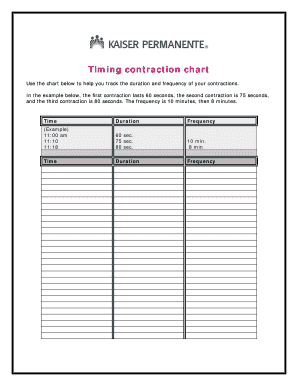

It may follow the typical stages and times of labor as described above but, in some cases, women may experience rapid or prolonged labor.ĭuring rapid or precipitous labor, a woman experiences only active labor, birth and delivery of the placenta this type of labor typically lasts anywhere from 3-5 hours in duration.Īlternately, there are some women who experience a prolonged labor or failure to progress. Labor duration can vary from woman to woman. Women will often experience shaking and shivering during this stage of labor. The third stage of labor is the time when the placenta (afterbirth) is delivered and takes around 5-30 minutes. This is the time when you will push and lasts for 20 minutes to 2 hours.
CONTRACTION TIMING ACTIVE LABOR FULL
The second stage of labor is the time of full dilation (10 cm) to birth. There is only 30 seconds to 2 minutes of rest in between contractions. Contractions are intense and last 60-90 seconds in duration. The transition phase generally lasts for 30 minutes to 2 hours. This phase is often accompanied by nausea, hot flashes, chills and shaking. The transition phase is the time from 7 cm to full dilation to 10 cm. Contractions become stronger, lasting for about 45-60 seconds in duration, and there is 3-5 minute rest period between contractions. When the active labor phase starts, you should head to the hospital. The active labor phase is the time from 3-7 cm cervical dilation. Most likely, you will be at home during this phase. During this time, the amniotic sac may rupture (also known as when the water breaks). These contractions will soon become regular and more intense. There is a 5-30 minute rest period between contractions which cause symptoms such as lower backache, cramping and pelvic pressure or tightness. Contractions are mild, irregular and last for about 30-45 seconds in duration. The early phase is the time at which labor begins until the cervix is dilated to around 3 cm. The first stage of labor is divided into three phases: early, active and transition.

This period can last anywhere from 12-19 hours in duration. The first stage of labor describes the time at which labor begins until a woman’s cervix is fully dilated to around 10cm.

There are three stages of labor: the first, second and third stages. If you have questions about any symptoms you may be having during this time, it is important to speak with your health care provider to determine if there is a need to be seen in the office or hospital. If your water breaks, labor will likely ensue and your health care team should be notified. The nesting instinct is not experienced by everyone, however.Īdditionally, some women may experience a bloody mucus discharge indicating the loss of their mucus plug as labor nears. At times, a woman may notice that the baby is sitting lower in the pelvis this is referred to as “dropping” or “lightening.”Ĭervical changes may become present on physical exam, and “nesting” – a strong desire to tidy and organize the house – may become more evident. There are several signs that labor may start in the near future. They may resolve with walking, lying down or through other changes in activity, but true contractions and labor will not resolve and will increase in intensity. If you are having Braxton Hicks contractions, they will be irregular and go away in time. You may think that knowing when you are in labor is obvious, but for many women, it may not be so simple. At times, women may experience symptoms of false labor, including Braxton Hicks contractions (also known as practice contractions) which, although similar to real contractions, are not labor.ĭetermining what is real labor and false can be accomplished by clocking contractions, timing how long each contraction lasts for and how long it takes from the start of one contraction to the next.


 0 kommentar(er)
0 kommentar(er)
